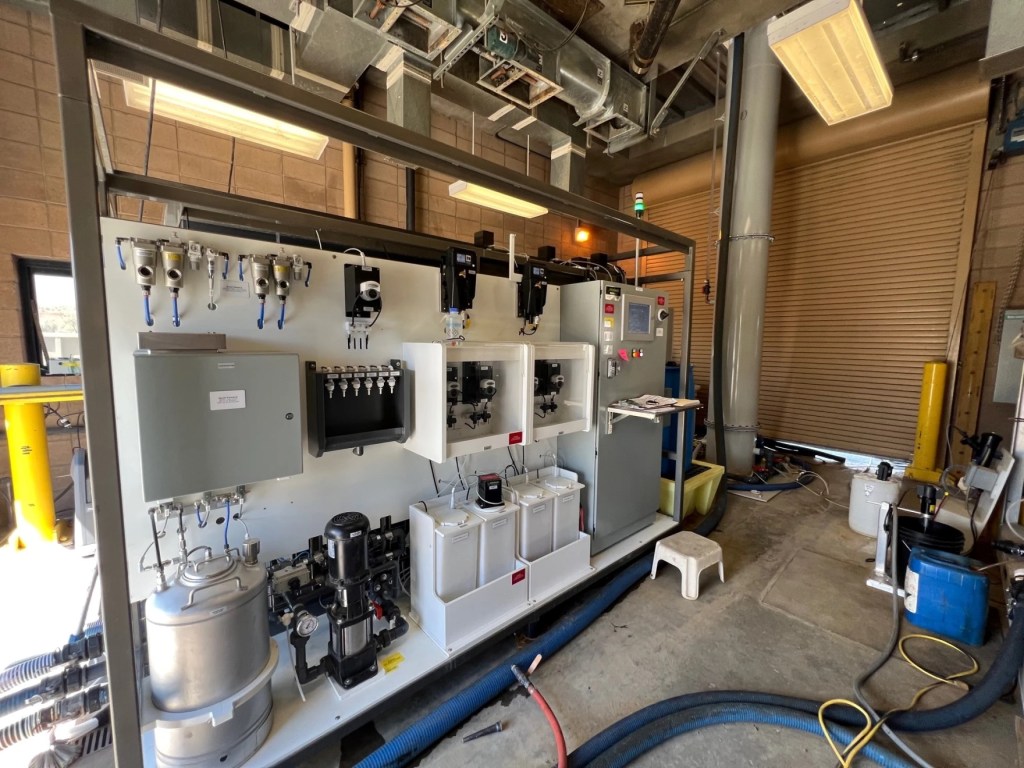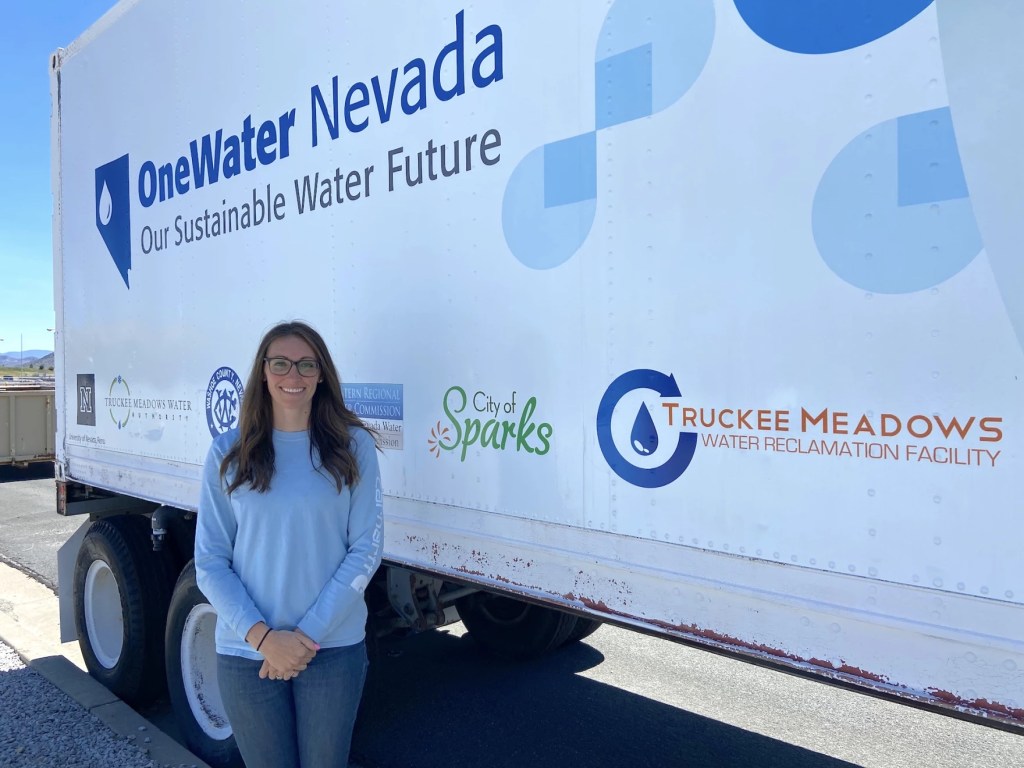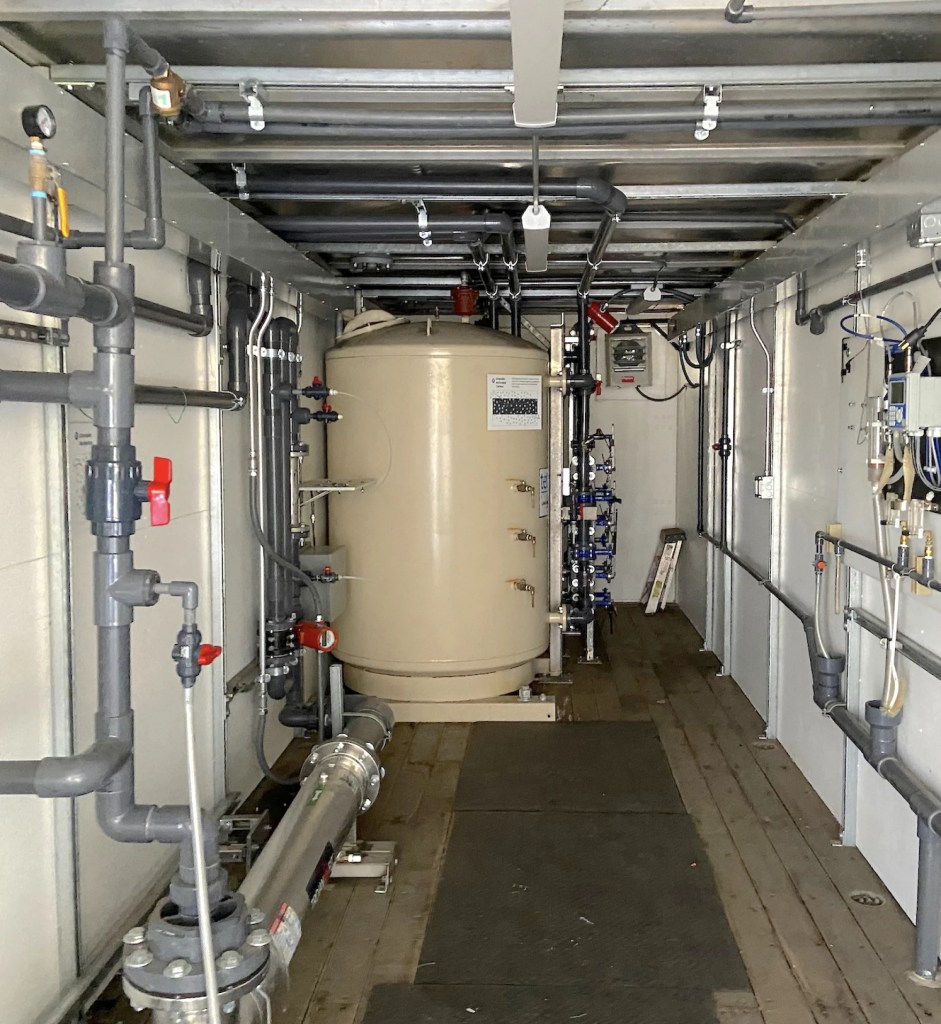Reno Is Preparing To Turn Its Wastewater Into Drinking Water
7:47 minutes

 This article is part of The State of Science, a series featuring science stories from public radio stations across the United States. This story was inspired by an article by Kaleb Roedel for KUNR.
This article is part of The State of Science, a series featuring science stories from public radio stations across the United States. This story was inspired by an article by Kaleb Roedel for KUNR.
Inside a water treatment plant in north Reno, Nev., on a recent Wednesday, recycled wastewater was running beneath a floor grate inside a small testing room. Inside the space is a system of serpentine-like PVC pipes with 19 different ports, used to test water samples at different intervals.
“It’s about halfway through the treatment process at the wastewater facility,” said Lydia Teel, an engineer with the Truckee Meadows Water Authority, or TMWA, which serves about 440,000 people in the greater Reno area. “So, it’s clean, but there’s still some color, there’s bacteria in it, some solids.”
Teel spearheads a demonstration project called OneWater Nevada, an effort to show that the region can recycle the water that flushes down people’s toilets and shower drains and – eventually – turn it back into clean, pure drinking water flowing from faucets, effectively creating a new water resource. The project is a collaboration between TMWA, the cities of Reno and Sparks, the University of Nevada, Reno, Washoe County, and the Western Regional Water Commission.
The Reno area doesn’t have a history of threatened water supplies, and historic snowfall this past winter eased drought conditions in Nevada and across parts of the Mountain West. But that could shift quickly with climate change.
“We don’t know if we would have years-long droughts,” Teel said. “We don’t know if there could be a catastrophic fire on the Truckee River where the quality is decreased for a period of time.”

Teel said many advanced purified water facilities are in coastal communities and use a technology called reverse osmosis. But that process, she noted, generates brine that gets sent to the ocean.
“We don’t have that luxury here – we wouldn’t know what to do with the brine,” she explained.
That’s why Teel and her colleagues tried a new technology that uses a combination of charcoal filtering and adding ozone. After years of tests beginning in 2017, they’ve proven their recycled wastewater meets national and state safe drinking water standards.
Now, project leaders are designing a large-scale facility that’s scheduled to break ground next year. Teel says the facility will cost about $120 million to build, and “a few million more” to operate each year.
“People are watching us because we are an inland community,” she said. “And we’re really breaking ground as one of the first communities in the nation to be looking at technology like this.”
Similar projects are planned in the fast-growing Mountain West. This year, Colorado became the first state to adopt regulations for direct potable reuse, the process of treating wastewater and sending it to people’s taps without an environmental buffer like ground or surface water.
The city of South Jordan, Utah, is testing purifying its wastewater to safe drinking levels. Officials say it’s for demonstration and education only, and to find out if that’d be a viable option in the future if needed.
Reno’s treated water won’t hit people’s taps right away. First, the water will be monitored and used to irrigate nearby alfalfa fields. A year later, it’ll be injected into the groundwater, stored for a few years, extracted, and tested some more.

“Then when we all feel comfortable, the public feels comfortable, then we can open the door of providing it to the public for potable use,” Teel said.
Making consumers feel comfortable might be the biggest hurdle, Teel admitted. That’s why the project team is demonstrating its purification system at community events, using the inside of a semi-trailer as a mobile treatment lab.
That can have a big impact on the public, said Mark Millan, founder of Data Instincts, which does public outreach for recycled water projects across the West, including OneWater Nevada.
“When people start to really understand the purification process, they almost think, ‘Oh, gosh, I’d rather have this water than bottled water because it is so clean,’” Millan said.
Drinking recycled wastewater is nothing new. Newsha Ajami, chief development officer for research at the Lawrence Berkeley National Laboratory’s Earth and Environmental Sciences Area, often reminds people that it’s been done for decades, starting with astronauts in space.
“What happens in the spaceships is they recycle their urine and other water they use and drink it,” she said. “So, the technology has been there for a long time.”
Ajami said purification projects will become even more important in the future, especially in the arid West where supplies can run dry.
“The more we can do this at every scale, the less we need to take out of the environment,” she said. “So, in that way, we can also protect our ecosystem. So, I would say, reuse and recycling at every scale is going to be part of our resilient water resilience portfolio in the future.”
Back at the testing room in Reno, Teel said their three pilot trailers were producing more than 14,000 gallons of advanced purified water per day. The full-scale plant will produce up to 2 million a day. To put that into context, Reno area residents use more than 100 million gallons of water daily in the summertime, according to Teel.
“To have another resource as a part of our drinking water in this area is huge,” she said. “You never know what’s in the future, and it’s just another drop in the bucket for us.”
Teel said the Reno area could have underground storage of waste-turned-clean drinking water as early as 2029.
As a note of disclosure, Truckee Meadows Water Authority is a business sponsor of KUNR.
This story was produced by the Mountain West News Bureau, a collaboration between Wyoming Public Media, Nevada Public Radio, Boise State Public Radio in Idaho, KUNR in Nevada, KUNC in Colorado and KANW in New Mexico, with support from affiliate stations across the region. Funding for the Mountain West News Bureau is provided in part by the Corporation for Public Broadcasting.
Kaleb Roedel is a Mountain West News Bureau Reporter at KUNR in Reno, Nevada.
IRA FLATLOW: This is Science Friday. I’m Ira Flatow.
KATHLEEN DAVIS: And I’m Kathleen Davis. And now it’s time to check in on the state of science.
[MUSIC PLAYING]
SPEAKER 1: This is KERN–
SPEAKER 2: For WWNO–
SPEAKER 3: Saint Louis Public Radio.
SPEAKER 4: Iowa Public Radio News.
KATHLEEN DAVIS: Local science stories of national significance. As the effects from climate change intensify, some regions will need to get creative when it comes to sourcing drinking water, especially those in drier parts of the country. Coastal cities have the option to invest in technology like desalination plants. But what about communities that don’t have easy access to a large body of water?
In Reno, Nevada, they’re exploring wastewater recycling as a solution– converting the water that flushes toilets and showers into purified, safe, drinking water. But will the public be on board for all of this? Joining me to talk more about these efforts is my guest Kaleb Roedel, Mountain West News Bureau Reporter for KUNR. He’s based in Reno, Nevada Welcome to Science Friday.
KALEB ROEDEL: Hi, Kathleen. Thanks for having me.
KATHLEEN DAVIS: Can you tell us a little bit about Reno and Nevada’s drinking water availability in general?
KALEB ROEDEL: Yeah. So right now, Reno has plenty of drinking water. Most of it comes from the Truckee River. And this past winter was one of the wettest on record. So the river and the area reservoirs are pretty full right now.
Down in Southern Nevada– the Las Vegas area– there’s more concern. That’s because 90% of their water comes from the Colorado River, which some people call ground zero for climate change. It’s been shrinking for decades because of overuse and drought. But, again, because of the wet winter we just had, it’s in better shape than in years past. So there’s no immediate threat to drinking water there either.
KATHLEEN DAVIS: So in some ways, this project that you’re going to tell us about is a way to maybe pad in the below in the future. Is that right?
KALEB ROEDEL: Exactly. So six years ago, several agencies in the region started a pilot project called One Water Nevada. And the goal was to take the wastewater, like you mentioned, that flushes down people’s toilets and recycle it into clean drinking water.
Some people call this From Toilet to Tap. And they’ve worked on this for years on a pretty small scale. And they consistently proved that it was meeting national and state safe drinking water standards.
So now project leaders are in the process of designing a wastewater recycling plant that’s scheduled to break ground next year. And that large scale plant is expected to recycle up to 2 million gallons of wastewater per day.
KATHLEEN DAVIS: Wow. So how is this wastewater recycling going to work?
KALEB ROEDEL: Well, I’ll start by pointing out what makes this project different. Like you mentioned at the top, a lot of advanced purified water facilities are in coastal communities. And the technology they often use– like you said, desalination. Some use reverse osmosis.
And that’s a membrane that basically takes everything that’s bad in the water and concentrates it into a brine. And then that brine gets dumped into the ocean. Since Reno’s nowhere near the ocean, they don’t have that option.
So they’re using a newer technology to purify their water. It’s a combination of charcoal filtering and ozone. Adding ozone to water breaks down organic compounds into smaller particles.
Then they add what they call a coagulant– a chemical that causes those small particles to stick together– so they can be removed easily. And that’s where the carbon filtering comes in and removes them. So there’s more to it but those are the big steps to turn the wastewater into drinking water.
KATHLEEN DAVIS: So as you said, some people call this project From Toilet to Tap. I can imagine there might be a mental block for some people to getting on board with this. I mean, what’s the city doing to help warm people up to this?
KALEB ROEDEL: Well, that’s a great question. They use the inside of a semi-trailer as a mobile treatment lab. And they’ve been bringing that to community events around Reno, so residents can see the treatment process and learn about the science and technology that goes into purifying the wastewater.
The facility itself will also have a large demonstration area where people can see the process on a big scale. And they’ll even give tours for people to the plant. Because at the end of the day, the project leaders told me that the biggest hurdle isn’t the technology. It’s gaining public trust and getting people over the quote yuck factor of drinking recycled wastewater.
And if you’re wondering, I didn’t try the water because they didn’t have a sample available. And I will say my wife suggested not to try any if I was offered.
[CHUCKLING]
There might have been a veiled threat of never kissing me again if I did. So she lucked out, and I guess I did, too. But seriously, I totally would have tried it. I was convinced that they were producing safe drinking water.
KATHLEEN DAVIS: OK. I’m Kathleen Davis, and this is Science Friday from WNYC Studios. So as you said, I mean, the West has had a wetter year than we’ve seen in the past few years. Why invest in this now?
KALEB ROEDEL: So when they started this effort six years ago, the Reno area was in a stretch of very severe drought years. And at the same time, the population here was booming.
Now, six years later, Reno is still one of the fastest growing cities. We’ve had some wet winters recently. So that’s helped stave off concerns of water supplies being affected. But that can shift pretty quickly in the age of climate change.
Here’s Lydia Teel. She’s an engineer and project leader with the Reno area’s water utility.
LYDIA TEEL: We don’t know if we would have years-long droughts. We don’t know if there could be a catastrophic fire on the Truckee River where the quality is decreased for a period of time. We don’t know. And so having this is just one more drop in the bucket for the community.
KATHLEEN DAVIS: So when is Reno actually planning to integrate this recycled wastewater into the drinking water?
KALEB ROEDEL: Well, the facility is expected to be finished by 2026. And during the first year that it’s up and running, the purified water will be monitored and used to irrigate nearby alfalfa fields.
And if it’s meeting safe drinking levels during that time, the next step will be injecting it into the groundwater. It will be stored there for a few years in the aquifer. Then it’ll be pulled up from the groundwater and tested some more.
And if that water is still clean and safe for drinking, then they’ll keep it banked underground for future use, kind of like a rainy day fund that they’ll keep adding to. And then that water could be available for use as early as 2029. But they obviously hope they don’t need to send it to people’s taps that soon. In this case, it’s the later the better.
KATHLEEN DAVIS: So I imagine that nearby communities will be watching how this program in Reno develops. Do you think that these wastewater recycling systems are going to become more common in the next few decades?
KALEB ROEDEL: Yeah. Experts I spoke with believe they will. In the West, there’s largely more demand for water than there is supply. And using and recycling every drop of water could become a necessity as the planet continues to warm.
This year, Colorado, for example, became the first state to adopt regulations for treating wastewater and sending it directly to people’s taps. And California has been at the forefront of these wastewater recycling efforts. There’s more than a dozen across the state.
And right now, there’s a proposed facility in Los Angeles County that would be the biggest one yet. It would send up to 150 million gallons of recycled wastewater a day back into the drinking water supply. And right now, leaders of that project are in the phase of trying to convince policymakers and the public that it’s a project worth supporting.
KATHLEEN DAVIS: That’s all the time that we have for now. Thank you so much, Kalen.
KALEB ROEDEL: Thank you.
KATHLEEN DAVIS: Kaleb Roedel, Mountain West News Bureau Reporter for KUNR in Reno, Nevada.
Copyright © 2023 Science Friday Initiative. All rights reserved. Science Friday transcripts are produced on a tight deadline by 3Play Media. Fidelity to the original aired/published audio or video file might vary, and text might be updated or amended in the future. For the authoritative record of Science Friday’s programming, please visit the original aired/published recording. For terms of use and more information, visit our policies pages at http://www.sciencefriday.com/about/policies/
Dee Peterschmidt is a producer, host of the podcast Universe of Art, and composes music for Science Friday’s podcasts. Their D&D character is a clumsy bard named Chip Chap Chopman.
Kathleen Davis is a producer and fill-in host at Science Friday, which means she spends her weeks researching, writing, editing, and sometimes talking into a microphone. She’s always eager to talk about freshwater lakes and Coney Island diners.